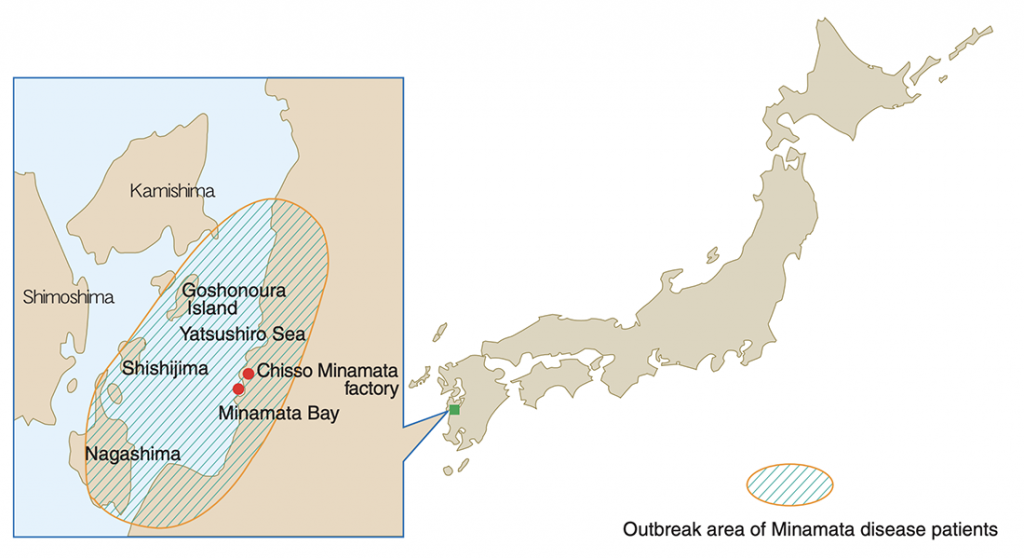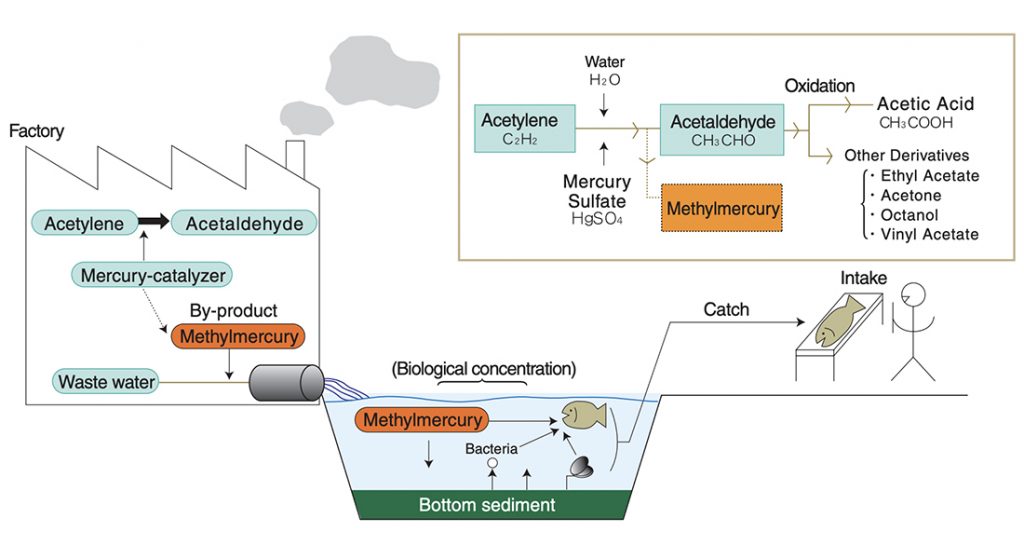Minamata Disease
Information & historical facts
What is Minamata Disease?
Where and when it happened?
Historically, it was first discovered in Minamata city in Kumamoto prefecture, which is in southwestern Kyushu island (next to Nagasaki prefecture), Japan in 1956.

Photo credit: Envionment Agency. Envionmental Health Dept. Our Intensive Efforts to Overcome the Tragic History of Minamata Disease
Japan experienced the consequences of environmental pollution and four major pollution-related diseases such as Minamata Disease, Niigata-Minamata Disease, Itai-Itai Disease, and Yokkaichi Asthma during the industrial revolution. Minamata disease is one of the pollution-related diseases due to the consequence of the release of methylmercury in the industrial wastewater from the Chisso Corporation, a chemical factory, which operated from 1932 to 1968).
A second outbreak of Minamata disease occurred in Niigata Prefecture in 1965. The original Minamata disease and Niigata Minamata disease are considered two of the four major pollution-related diseases in Japan.
How it happened?
The release of industrial wastewater from the Chisso Corporation contaminated with methylmercury bioaccumulated and biomagnified in shellfish and fish in the Minamata Bay and the Shiranui Sea. The seafood caught from those areas was widely consumed by the local people and resulted in mercury poisoning.

Photo credit: Kumamoto Prefecture. An Outline of the Enviromental Restoration of Minamata Bay. 1997
The very first known cases
On April 21, 1956, a five-year-old girl was hospitalized with the symptoms such as difficulty walking, difficulty speaking, and convulsions at nearby Chisso Corporation’s factory hospital in Minamata, Kumamoto. Two days later, her younger sister was also hospitalized as their mother informed the local doctors that her neighbor’s daughter also has similar symptoms as well. Furthermore, eight patients were discovered similar symptoms after the investigation.
On May 1, a report entitled “epidemic of an unknown disease of the central nervous system” was reported to the local public health office by the hospital director. In May 1956, the city government and various medical practitioners formed the Strange Disease Countermeasures Committee to investigate the epidemic, and then they discovered the localized nature of the disease as well as the evidence of the strange behaviors in the wildlife in the surrounding areas of the patients. Numerous cases of animals’ strange behavioral patterns such as the erratic movements of the cats local known as “cat dancing disease” and death had been reported during the investigation.
On August 24, 1956, the Kumamoto University Research Group was formed and the researchers from the School of Medicine tackled the situation by visiting Minamata regularly and examining the patients from the affected areas at the university hospital for detailed examinations. Gradually, a more complete picture of the symptoms exhibited by patients was discovered. The reports showed patients had numbness and loss of sensation in their hands and feet. They were also incapable of grasping small objects or fastening buttons. Furthermore, they couldn’t run or walk without stumbling, their voices altered pitch, and several of the patients complained of vision, hearing, and swallowing problems. In general, these symptoms progressively increased, eventually resulting in severe convulsions, unconsciousness such as coma, and death.
In the six months, from the very first known case in April to October of that year (1956), more than 40 cases (patients) were reported, and 11 of them died: a mortality rate of 36.7%.
Finding the Cause
Kumamoto University researchers started looking into this strange and rare disease’s cause. They discovered that the victims, many of them were members of the same family, were a part of fishing community living around Minamata Bay’s shore. Fish and shellfish caught from Minamata Bay were an everyday staple of the patients. Local cats, which liked to eat remnants from the family table, died of symptoms that were identical to those now known in the patients. The researchers concluded that the outbreak was caused by food poisoning, with contaminated fish and shellfish being the leading suspects.
“Minamata sickness is rather considered to be poisoning by a heavy metal …, it is most likely to enter the human body through seafood and shellfish.” the research group stated in their announcement on November 4, 1956.
The Beginning on the Investigation of Mercury
The wastewater from the Chisso facility was initially suspected as the source after the analysis indicated a heavy metal as the causal substance. Moreover, high enough concentrations of heavy metals such as lead, mercury, manganese, arsenic, selenium, thallium, and copper were found in the company’s wastewater to cause substantial environmental deterioration, according to the company’s own studies. However, determining which toxin was responsible for the ailment became incredibly difficult and time-consuming at that time.
During the years 1957 and 1958, a variety of theories regarding the clues on a multiple contaminant hypothesis such as Manganese, Thallium, etc. were suggested by various researchers due to the high quantities found in fish and the deceased’s organs. In March 1958, the focus of the inquiry altered to Mercury, when visiting British neurologist Douglas McAlpine indicated that Minamata symptoms resembled those of organic mercury poisoning.
The investigation on the distribution of mercury in Minamata Bay shocked the researchers in February 1959. Mercury was found in large amounts in the bay’s fish, shellfish, and sludge. The largest quantities were found near the Chisso industrial wastewater canal in Hyakken Harbour, with concentrations decreasing as they traveled out to sea, indicating that the facility was the source of contamination. A value of 2 kg of mercury per ton was measured at the wastewater canal’s mouth, a level high enough to make mining commercially viable. Moreover, hair samples of the patients and nearby community of Minamata Bay were investigated. The highest mercury level found in patients was 705 parts per million (ppm), indicating severe exposure; 191 ppm in non-symptomatic Minamata residents, compared to 4 ppm for persons living outside the Minamata area.
The Announcement
The Minamata Food Poisoning Subcommittee of the Ministry of Health and Welfare published its findings on November 12, 1959 as followed:
Minamata disease is a poisoning disease that mostly affects the central nervous system and is caused by consuming significant quantities of fish and shellfish caught from Minamata Bay and its surrounding environment, with organic mercury compounds being the primary causative agent.
Reference
- Minamata Disease. Retrieved from https://minamata195651.jp/pdf/kyoukun_en/kyoukun_eng_all.pdf
- Hamdy MK, Noyes OR. (1975). “Formation of Methyl Mercury by Bacteria” (PDF). Appl. Microbiol. 30 (3): 424–432. doi:10.1128/AEM.30.3.424-432.1975. PMC 187198. PMID 1180551. and references therein.
- Official government figure as of March 2001. See “Minamata Disease: The History and Measures, ch2”
- “Minamata Disease Archives” Archived 2016-03-03 at the Wayback Machine, Frequently asked questions, Question 6
- Jane Hightower (2008). Diagnosis Mercury: Money, Politics and Poison, Island Press, p. 77

